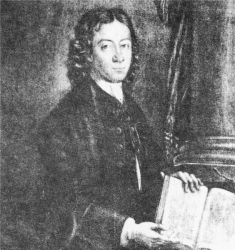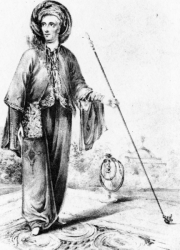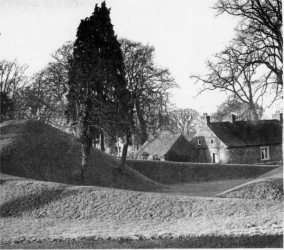THE PRESENT CHURCH BUILT IN
1835 BY BASIL PATRAS ZULA, ON THE SITE OF THE
ORIGINAL CHURCH BUILT BY JOHN CENNICK IN THE
YEAR 1755.
EUROPEAN ORIGINS
The Moravian Church originated in Bohemia and Moravia
? now Czechoslovakia -- from among the followers of the Czech reformer
and martyr John Hus. In 1415 Hus was condemned to death as a heretic by
the Council of Constance because he had dared to question the power of
the Papacy. He was burned at the stake on July 6th, 1415 and his ashes
were strewn on the waters of the River Rhine. A small group of his
followers settled in a remote valley in Bohemia and there, in the little
village of Kunwald, they tried to mould their lives on Christ's teaching
in the Sermon on the Mount. They called themselves "The Brethren of the
Law of Christ" and to begin with they had no idea of founding a separate
Church. But some years later, in 1457, after attempts to reform the
Roman Catholic Church from within had failed, they decided to set up
their own Church. They gave it the Latin name "Unitas Fratrum" which in
English. is "Unity of Brethren". A long and difficult period of
opposition and persecution followed but in spite of this the newly
formed Church began to prosper and to increase in numbers and in
influence. Its success was largely due to the emphasis it placed on the
position of the laity in the Church and their active participation in
its worship and government. To encourage this the Unitas Fratrum
produced the first Protestant Hymn Book in Prague in 1501, to be
followed in 1579 by the printing and publication of the Kralitz Bible, a
translation of the Bible into the Czech language from the original
Hebrew and Greek. The Unitas Fratrum also laid great emphasis on
Christian education and founded many schools and colleges.
But in the early part of the 17th Century in the
religious wars which decimated central Europe, the ancient Unitas
Fratrum was almost wiped out. Its services were forbidden, its Churches
destroyed and its members persecuted and killed. In the face of this
terrible attack only a small group of its members survived. They were
led by one of its Bishops. John Amos
Comenius, the famous educationalist, out of Bohemia
and Moravia into Poland and Silesia. From there, together with other
refugees from Bohemia and Moravia, they found refuge on the estate of a
German nobleman, Count Nicholas Ludwig von Zinzendorf. Here, in 1727,
the ancient Unitas Fratrum was re-born and one of the first results of
that spiritual rebirth was a great outpouring of overseas Missionary
activity in which Moravian Missionaries carried the Christian Gospel to
places as far afield as the West Indies, Greenland, South Africa. South
America, Labrador and North America. It was in connection with the
Moravian Mission to the Red Indians of North America that the Moravians
first came to. Britain.

THE MORAVIANS IN GREAT BRITAIN AND
IRELAND
The arrival of the first members of the Moravian
Church in Britain coincided with the beginnings of the great evangelical
revival which was to lead to the formation of the Methodist Church. John
and Charles Wesley, after revival experiences at Oxford, felt led to go
to North America on a mission to the North American Indians in the newly
established British
Colony of Georgia. They travelled to Georgia on the
sailing ship `Simmonds' on board which were some Moravian Missionaries
also bound for North America. This meeting had momentous results both
for Moravians and Methodists. The original contact made on board the `Simmonds'
was followed, on Wesley's return from America, by his friendship with
Peter Boehler the Moravian Bishop who was instrumental in leading John
Wesley to complete conversion. Moravians and Methodists now began to
work together in London, in Yorkshire and in the West of England. Among
those who assisted John Wesley in his work in the Bristol area was a
young man named John Cennick. For a time he taught in a Methodist school
in Kingswood for the children of the miners, but when the Moravians and
the Methodists later separated because of doctrinal and organisational
differences, Cennick withdrew to 1Tytherton in Wiltshire and became a
Minister in the Moravian Church.


JOHN CENNICK, THE FAMOUS
MORAVIAN PREACHER AND HYMN WRITER, AND THE
FOUNDER OF THE MORAVIAN CHURCH IN IRELAND.
About 1745, Cennick was invited to come to Ireland
and begin an evangelical campaign there. At first the Moravian Church
refused to release him for this work but later they agreed to do so. He
arrived in Dublin in 1746 and thousands of people gathered to hear him
preach, and two years later he founded there the first Moravian
Congregation in Ireland. Among those who heard him preach in Dublin were
two businessmen from Ballymena in Northern Ireland. They invited him to
come there and he accepted their invitation. But he was so fiercely
opposed that he nearly lost his life, and he had to give up and return
to Dublin. But two years later he was back again and within the next few
years he had founded religious Societies in Counties
Antrim, Down, Derry, Armagh, Tyrone, Cavan, Monaghan
and Donegal. From among these Societies Moravian Congregations were
formed and Moravian Churches built at Ballinderry, Kilwarlin, Gracefield
and Gracehill. The Kilwarlin Congregation was founded and the first
Church was built by Cennick in 1755. Four years later a small piece of
land was purchased near the Church to serve as a Burial Ground. The
original Congregation numbered about 80 members and for a time it had
its own resident Minister. But by 1813 a decline in the work had set in.
The resident Minister was removed and the Kilwarlin work was put under
the charge of the Moravian Minister at Ballinderry. This removal of the
resident Minister led to still further decline and by 1834 the original
Church and Manse built by Cennick were in ruins and the Congregation
membership had dwindled to just six elderly people. It looked as if it
would only be a matter of time until the Moravian work at Kilwarlin was
extinguished.


ZULA IN HIS GREEK CHIEFTAIN'S ROBES.
That the Moravian work at Kilwarlin did not perish
but was given a new and vigorous lease of life was due almost entirely
to a "foreigner" ? a Greek Chieftain named Basil Patras Zula. The famous
English poet, Lord Byron, who died in Greece in 1824 while helping the
Greeks in their war of independence against the Turks, once wrote these
lines:-
" Tis strange?but true; for truth is always
strange:
Stranger than fiction."
Byron's words are amply confirmed by the `strange?but
true' story of how Zula, a Greek soldier in that independence struggle
against the Turks became the Minister of the Kilwarlin Moravian
Congregation and by his self-sacrificing labours saved it from
extinction. He was born in Greece in the year 1796 the son of a Greek
Chieftain who had already fought and suffered in the Turkish war. His
father died when he was only five years of age, and when he reached the
age of eleven the leaders of his clan insisted that he take over the
Chieftainship or abdicate. So, Basil found himself transferred from the
Schoolroom to the Battlefield and the Turkish general, Ali Pasha, on
hearing of his appointment put a price on his head. On more than one
occasion he and his widowed mother only just escaped with their lives
from Turkish ambushes. For a period he had to take refuge in Italy but
in 1822 he returned to Greece in time to take part in the terrible
fifteen month Turkish siege of the Greek city of Missolonghi. Following
the capture of Missolonghi and its destruction by the Turks dreadful
atrocities were carried out by both Turks and Greeks and sickened by
this slaughter Zula withdrew from the struggle and went to Smyrna. Here
he met an English nobleman named Sir William Eden and later became his
travelling companion.

Early in 1828 Sir William Eden returned to England
and from there took Zula with him on a visit to Ireland. They landed in
Dublin and stayed at the Bilton Hotel in Sackville Street. Zula was
later to write in his Diary:--
"I entered the City of Dublin a
self-made exile, without country, religion or
friends; but being led by an Unseen Hand, l was
there to find them all."
In fact, he "found them all" in the person of a
Dublin Moravian School - mistress named Ann Linfoot whom he met in the
Bilton Hotel c n the morning after his arrival there. The meeting came
about as follows. Mr. Bilton, the Proprietor of the Hotel, was a very
religious man who began each day with family prayers to which he invited
his Hotel guests. Sir William Eden and his entourage attended these
devotions on their first morning in the Hotel. But it so happened that
on this particular day, Mr. Bilton, being away from home on business,
had invited Ann Linfoot to deputise for him. She was a member of the
Bishop Street Moravian Church founded by John Cennick, and after the
morning prayers were over she was introduced to Zula. To his great
delight, he discovered that she knew Greek and could converse with him
in his native tongue. She invited him to attend the Services in Bishop
Street and a close friendship grew up between them. Zula became
intensely interested in the history and work of the Moravian Church and
eventually he offered himself for training for its Ordained Ministry. He
was accepted and was sent for a period of instruction in the Moravian
Settlement in Gracehill. When this was completed, he returned to Dublin
and on Easter Day, 1829, he and Ann Linfoot were married in the Bishop
Street Moravian Church. Zula afterwards wrote in his Diary of his Bride:
"She was the instrument whom
the Lord employed to draw me to himself. I owed
her a deep debt of gratitude and having nothing
else to offer her, I offered myself and was
accepted."
In 1834, following further training for the Ministry,
Zula and his wife were `called' to serve the dying Moravian Congregation
in Kilwarlin.

THE RESCUE OF KILWARLIN
The scene which greeted Zula and his wife on their
arrival in Kilwarlin was daunting, to say the least ? the Church and
Manse falling into ruins, the grounds and gardens a tangled wilderness
and a `congregation' consisting of six elderly people. But they were not
daunted. Within a few days they were settled in Kilwarlin and some
sentences from Zula's Diary serve to show the spirit in which their work
was begun and carried on:?
"Who am I O my God," wrote Zula, "or
what is my father's house that thou shouldst honour me to
help to build up the old waste places. From a far country
have I journeyed, and found rest here; and at thy altar do I
anew dedicate body, soul and spirit to be devoted to thy
glorious service."
His first sermon was preached in the old Church on
September 14th, 1834 on the text from I Timothy 1 : 15, "Here are words
you may trust, words that merit full acceptance: `Christ Jesus came into
the world to save sinners: and among them I stand first.' " But the
Church building was in such a ruinous state that to continue to hold
services there was downright dangerous and a few weeks later Zula began
the work of demolishing it to make way for a new building. The new
Church was completed and opened for worship in March, 1835 and on that
occasion, twenty-six new members were added to the Congregation. Soon
after the opening of the new Church, Zula re-built the Manse and a small
day-school which he built at the entrance to the Church grounds was
opened for use. During all this building work, his wonderful pastoral
care and preaching ability were fully maintained and were reflected in
the steady increase in membership of the Congregation. As a result, the
Moravian authorities agreed that the time had come for Zula to be
advanced from the position of `Probationer' working under the guidance
of the Ballinderry Minister to become an Ordained Minister in full
charge of Kilwarlin. In January, 1837, his Ordination was carried out by
the Right Reverend Hans Peter Hallbeck, a Moravian Bishop who was at
that time on a visit to Ireland from his Moravian Missionary work in
South Africa among the Hottentot people there. It was shortly after his
Ordination that the Congregation presented him with a handsome
grandfather clock, "as a testimony of our esteem and affectionate
regard." The clock is preserved in the vestry of the present Church.

A MEMORY OF HOME
It must have been a great deprivation to Zula that he
was never able to revisit his native Greece and it was probably this
sense of loss which led him to construct in the Church grounds at
Kilwarlin a very strange reminder of his homeland. Using his private
resources, he employed local labour to lay out the Church grounds on the
plan of the famous Greek battle of Thermopylae.

'ZULA'S HOLLOW', SHOWING PART
OF THE PLAN OF THE BATTLE OF THERMOPYLAE.
In this battle King Leonidas of Sparta with a handful
of Spartan soldiers held up the full might of the Persian army as it
tried to break through the narrow pass of Thermopylae to attack the city
of Athens. Within a circular "hollow" formed by the Church driveway,
this strange battlefield in a garden was constructed. Six stone steps
leading down into the hollow represent the eastern entrance to
Thermopylae. Opposite them, near the entrance gates, is a grassy hillock
the Mount Acta of the original battlefield. To the right of the Church
driveway as seen from the Manse entrance is a small ornamental lake
representing the Aegean Sea and from this lake an underground stream,
representing the hot springs which gave Thermopylae its name, runs
through the hollow. On the left of the hollow is a grassy slope
representing the foothills of the Callidromon range of mountains through
which the pass of Thermopylae ran and beyond it a loftier mound which
represents Mount Callidromos. Between the lower and loftier mounds is a
narrow defile which represents the secret pass revealed to the Persians
by a Greek traitor and which enabled the Persians to attack Leonidas and
his men from the rear and annihilate them. In the middle of the hollow
is a small ornamental pond around which were originally twenty-four
flower beds each in the shape of a letter of the Greek alphabet. Only
two now remain Alpha and Omega ?marking the beginning and ending of the
original circle of twenty-four.

UNTIMELY DEATH IN DUBLIN
Zula died soon after he constructed this reminder of
his native Greece. But even in exile in Ireland he could not wipe from
his memory what he and his people had suffered at the hands of the Turks
and he continued to have an intense hatred and an irrational fear of
them. So when re-building the Kilwarlin Manse, lie provided it with a
number of escape mechanisms - two doors in all the downstairs rooms, two
separate staircases and outside at the back a small room built on
"stilts" with a trap-door leading to a hiding place under the floor.
Fortunately, he was never to need any of these escape routes, for he
died a natural death in Dublin on the 4th October, 1844. His body was
brought back to Kilwarlin and interred in the little Burial Ground at
the rear of the Church which he had erected. After his death his widow,
Ann, lived on in the Manse and using money from his estate built an
additional wing to the Manse in which she conducted a "Boarding School
for Select Young Ladies." She died in 1858 and is buried alongside her
husband.
As we contemplate the chequered history of the
Kilwarlin Moravian Congregation and in particular this "strange but
true" story of how a Greek Chieftain became its revered and beloved
Minister and saved it from extinction, we may wonder how it was possible
for him, a foreigner and a stranger, to win the hearts and affections of
these simple folk. Without doubt the answer is to be found in the way in
which by his zeal, devotion and love the prayer which he recorded in his
Diary on taking up his work in Kilwarlin ten years previously was so
richly fulfilled.
"Enable me O Lord, to sink myself in the
care of those aground me; to sympathise. to pity, to have a
fellow-feeling for their wants, joys and sorrows and to be truly
concerned for the spiritual welfare of all. "
And if we are looking for some suitable memorial of
his life and work perhaps we could not do better than quote the
inscription on the tomb of Sir Christopher Wren in St. Paul's Cathedral
in London:-
"Si momumentum requiris, circumspice."
"If you ask where is his monument - Look around
you.''
 |